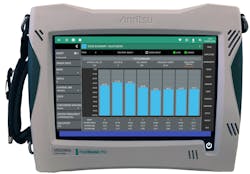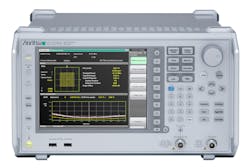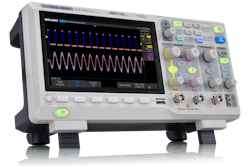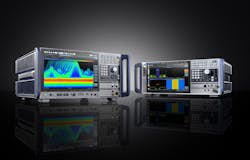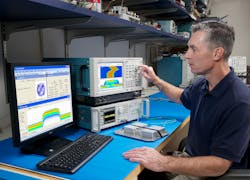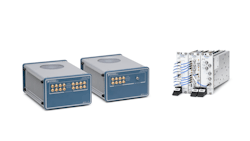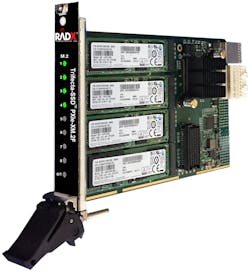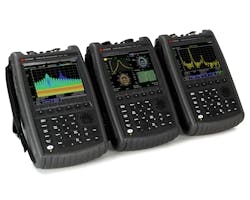for data exponentially are growing with seemingly no end. Sub 6 GHz spectrum is somewhat overcrowded currently and is unable to provide sufficient bandwidth required for increasing data demands. Thus, mmWave is seen as the only viable solution as there are adequate blocks of available wide bandwidth spectrum.”
“We’ve seen that more markets are opening up in mmWave—automotive radar, for example—and point-to-point radio links,” added Anritsu product marketing manager Angus Robinson. “There is a movement toward wider vector signal analyzer (VSA) bandwidths, especially to support 5GNR measurements. Bandwidths of 100 MHz are now common, including greater than 400 MHz on premium benchtop instruments. We’re starting to see real-time signal analysis (RTSA) being offered as option in regular SPA/VSA for interference hunting.”
To look closer into what’s driving developments in this signal/spectrum analyzers, we at Evaluation Engineering asked vendors to tell us what they’re seeing as far as technology trends, vendor challenges, and customer demands, as well as what new solutions they’ve recently made available. Here’s what they told us.
What’s trending?
What technology or market trends are vendors seeing in the area of signal and spectrum analyzers?Belleau, Anritsu: “Semiconductor technologies have continuously evolved and today are able to meet the requirements for efficient & cost-effective components/systems required to utilize the mmWave spectrum. This trend toward mmWave usage creates needs for cost-effective mmWave test equipment. New coaxial connectors have already been developed to support measurements >110 GHz, however there are very few test & measurement instruments capable of operating >110 GHz, and most are banded waveguide, which makes broadband analysis of the devices difficult, if not impossible.”
Jason Chonko, applications marketing manager at SIGLENT Technologies North America: “Function integration has been a growing trend. Engineers and technicians want to have tools that are flexible and that provide answers to their complex problems quickly. This trend includes integrating VNA capabilities for testing RF components, cable fault location, and modulation analysis into a benchtop platform. Armed with this flexibility, a technician or engineer can approach an unknown situation and have better confidence that the tool will be the only one needed to finish the job.”
Chris Davis, RF instrumtation product marketing manager at National Instruments: "New technologies in cellular and connectivity verticals like 5G NR and 6-7 GHz Wi-Fi are not only pushing the limits of chipsets, but also test systems engineers who are characterizing performance and supporting manufacturing. Wider signal bandwidth requirements for technologies like 5G create a challenge: balancing the architecture of a tester and its instruments between bandwidth, noise management, and filtering. Also, engineers are seeing test plan requirements demanding support for more than a single device type or even a single standard. Despite these trends towards test complexity and broader test coverage, there is still a need to deliver results rapidly and with high confidence to hit market windows and remain competitive."
Dylan Stinson, USB RF product marketing manager at Tektronix: “A number of RF applications are demanding hardware and software that enable more sophisticated characterization of an increasingly busy RF spectrum. For example, the growing demand for unmanned aerial system identification technology forces government, military, and other customers to find drone signals in the same bands as pervasive commercial emitters such as Wi-Fi.”
Laura Sanchez and Johan Nilsson, spectrum analysis product managers at Rohde & Schwarz: “There is an increased need for higher measurement frequencies and wider bandwidth; this is because of new emerging technologies such as 5G NR, new space, and automotive radar. We have also seen a big change in the way satellites are tested. With the digital payload systems, customers are looking for a signal generator and analyzer-based solution with modulated signals, while a VNA-based solution was more common in the past.”
Ross Smith, co-founder and CEO of RADX: “Demand for multichannel, synchronized RF recorders with high-performance RTSA on one or more channels. RTSAs with support for 14, 18, 26.5, 44, and 50 GHz frequency range and bandwidths up to 250, 500, and 1,000 MHz RTBW. Requirements for RTSAs with both very low 100% POI and very fine RBW.”
Challenges
What key challenges are vendors or their partners facing in signal and spectrum analyzers?Belleau, Anritsu: “With the trend towards mmWave usage, challenges faced by test & measurement vendors today are to develop cost-effective solutions which in turn enable the continuing development of these mmWave devices. Without test & measurement equipment capable of making mmWave measurements, and at prices that are within reach of most typical organizations, development of mmWave devices would be severely hindered, which would delay the advancements in technology required to support the exponential data demands.”
Armstrong, National Instruments: "Vendors need to find ways to increase measurement performance while balancing the cost to the user, despite increasing bandwidths and frequencies. For example, analyzers and generators that could service the mmWave spectrum have existed for years. Their limited scope for applications (think satellite and defense programs with billion-dollar price tags), and the overall measurement complexity resulted in an understandably high cost. As the market evolves to make mmWave spectrum more ubiquitous in consumer technologies, there has to be an evolution in the instrumentation to support the advanced technical requirements at a cost that can scale, or the economics simply won't work. One example is the continued increase in port count for mmWave devices like beamformers; designing a switching network on top of a high-performance analyzer is not only technically challenging but also a burden on budgets and time."
Chonko, SIGLENT: “Keeping up. The development of new technologies and the price pressures associated with the IoT boom that is causing much of this growth in RF is simply difficult to manage. With no set protocol to focus on, vendors are stuck guessing which technologies to support. It’s not unprecedented, but it keeps things interesting.”
Robinson, Anritsu: “1) Delivering advanced feature sets in instruments with a user interface that can be learned quickly. 2) Segmentation of the market for interference hunting, wireless measurements, generic IQ analysis, and production test. 3) Increased mmWave frequency coverage for new 5GNR bands.”
Sanchez and Nilsson, Rohde & Schwarz: “The demand for better connectivity is constantly increasing; the end-users require higher data rates, lower latency, and bigger capacity. As the spectrum is getting more crowded, higher frequencies in the mmWave bands are being used. For example, the automotive radar moved from the 24 GHz to the 79 GHz band, and there are possibilities of exploring even higher frequencies in the near future.”
Stinson, Tektronix: “All test vendors face a similar challenge of presenting next-generation testing capabilities—higher bandwidths, sharper software, more advanced triggers, etc. to customers at prices that support their testing budgets.”
Smith, RADX: “For us, it’s addressing the highest frequency requirements of our customers, which— because we’re based on COTS modular—limits us to about 44 to 50 GHz.”
What are customers asking for?
What features or innovations are customers asking for in signal and spectrum analyzers?Belleau, Anritsu: “This question has several answers, and it is heavily dependent on what the customer is attempting to develop and/or test. R&D and academia environments continuously push the limits of technology, and often with limited budgets, so their needs are generally closely related to what they can obtain in the market within their budget. So, cost-effective mmWave measurement products allow these customers to forge ahead and overcome new barriers. Production environments typically require minimal features at the lowest cost, smallest form factors, low power consumption, and simplicity in operation. General-purpose environments typically tend to lean toward multiple functionality—the instrument that can support various measurement capabilities like spectrum and signal analysis (IQ demodulation, etc.) provides excellent flexibility for this type of environment.”
Stinson, Tektronix: “Ruggedized, portable systems for field and range testing applications; Increased channel counts are of related importance to many customers; Recording capabilities that enable extended logging of real-time RF data at high bandwidths; Advanced triggers that allow real-time spectrum analyzers to detect spurious, intermittent, or anomalous signals that swept-tuned instruments will miss.”
Sanchez and Nilsson, Rohde & Schwarz: “There is a general need for wider analysis bandwidths that go up to the GHz range, especially in radar and satellite applications. A good example is the flexibility to work with any kind of stimulus signals when characterizing components or systems in the aerospace industry. Customers that only tested with CW signals in the past are now working with digitally modulated signals, for example, when measuring error vector magnitude, etc. As always, features that automate measurements are in high demand.”
Armstrong, National Instruments: "First, as the evolution of standards and their test requirements becomes more agile relative to the creation of the chipsets to support them, they need to quickly adapt to the complex measurement science. A software experience that enables the user to quickly get to a working measurement—or multiple measurements across several standards supported by the same device under test—and then readily optimize for measurement speed helps to keep test time down despite the increasing size of test plans. Second, the convergence of multiple technologies into individual devices is demanding more and more from test teams and the hardware they use. They are looking for any innovation to help bring test time down by automating and optimizing for measurement speed and test execution. For analyzers, one of the ways to achieve this is by tightly integrating with a generator to synchronously configure a waveform, generate, acquire, analyze, and move on to the next waveform without waiting for manual re-configuration or slow SCPI servers. Finally, there's the asks for higher port counts on top of higher frequencies and bandwidths. Beyond only hitting the numbers, these require the calibration plane of an instrument to also extend to a device interface that could extend through any number of switches, couplers, and the like. Integrating this kind of signal conditioning within the bounds of the instrument wherever possible, relieves a layer of complexity from the user."
Smith, RADX: “Built-in RF record capabilities so an external recorder is not required; RTSAs with more demodulation and analysis capabilities; Ability to zoom into a region to look for small amplitude, frequency agile signals.”
Chonko, SIGLENT: “Many customers are interested in portable and handheld analyzers that can be used on-site or to track down interference in the field.”
Robinson, Anritsu: “5G NR measurements, IQ capture, wireless coverage mapping, and interference hunting tools.”
Advantages/disadvantages of configuration
Spectrum and signal analyzers come in a variety of configurations, such as traditional benchtop instruments, handheld instruments with display, USB instruments, and PXI modules. What do vendors see as the advantages and disadvantages of each?Belleau, Anritsu: “There is a continuing trend towards USB instruments, in particular. They bring a cost-effective advantage since they do not require the internal microprocessor, memory, display, and so on. USB instruments are generally extremely portable, and many make direct connections to the device under test, which eliminates errors caused by cables, etc. PXI modules, and variations of PXI modules, also offer some advantages, particularly in cases where multiport, simultaneous measurements are required. They do typically require a mainframe chassis, which makes them somewhat challenging to be moved from one location to another. Due to the physical form factor of the PXI module itself, there are often performance trade-offs in order to have the product fit within its constraints. Traditional benchtop instruments are gradually being replaced by these more modern USB and PXI equivalents, although for absolute highest performance requirements, benchtop analyzers are still required and will continue to be until such time that the USB or PXI based instruments are able to fully match the performance of the benchtop instruments.”
Chonko, SIGLENT: “Benchtop instruments generally deliver the best performance for the investment. This is mainly due to the heavy use of high-volume parts in their designs. Handhelds are very useful for field measurements, but they are usually higher cost with lower performance, due to the design challenges and more specific components required for battery-powered operation. USB instruments offer the lower cost and higher performance of a benchtop instrument in a somewhat more portable form factor, but they require a computer, software, and ultra-fast USB connection for full performance. PXI instruments and other modular products are very similar to benchtop instrumentation, but they don’t have displays or the ability to operate “on their own.” They require a somewhat costly mainframe and controlling computer. They are very well suited to fixed installation tests in manufacturing or long-term R&D tests.”
Armstrong, National Instruments: "Traditional box instruments remain the ultra-high-performance option that come with a price tag to suit. These are invaluable for teams that may have less well-defined technical requirements and therefore opt for umbrella coverage or need serious horsepower as part of their small-scale early development activities. This strength can become a weakness when additional variables come into the equation that just outreach the instrument's capability or when the application requires scaling one tester to multiple sites. This can lead to added cost by requiring additional instruments, feature upgrades, or licensing fees to transfer often expensive, proprietary measurement software. PXI modular instruments are the most flexible option with their inherent ability to mix-and-match instruments in a single chassis. PXI-based test systems can integrate multiple analyzers, as well as incorporate signal generators, switching, power supplies, digital instruments, and more for complete test automation. The shared hardware infrastructure in a PXI chassis means higher performance synchronization between analyzers or between analyzers and other instruments. This enables unparalleled measurement speed and support for multi-up, MIMO configurations in the same small form factor. However, PXI instrumentations have had a reputation for requiring more up-front development effort to take measurements and create a user interface."
Sanchez and Nilsson, Rohde & Schwarz: “While modular architecture may appear cost-efficient at first, there are hidden expenses for customers in terms of additional software development, training, and application support. Additionally, the suppliers of PXI modules do not always provide specifications that are thorough enough. A majority of customers prefer benchtop instruments. They are easier to configure, customers can start making measurements right away, and integration in measurement systems can be done easily via GPIB or LAN.”
Robinson, Anritsu: “Handheld instruments are becoming more in demand as customers make measurements in the field for network installation and optimization (interference and PIM hunting). Production environments require high speed of test, which is driving new analyzer configurations with signal processing performed off-platform.”
Multifunction vs. dedicated instrument
Today, digital oscilloscopes can perform fast fourier transforms (FFTs), and many now have dedicated spectrum-analyzer channels. What are the advantages and disadvantages of using the spectrum-analysis capabilities of an oscilloscope or other multifunction instrument vs. a dedicated signal or spectrum analyzer?Belleau, Anritsu: “Digital oscilloscopes fundamentally measure signals in the time domain. This limits their upper frequency measurement capability since higher frequency measurements require higher direct measurement bandwidth and higher bandwidth analog-to-digital converters (ADC). As ADC bandwidths increase, the number of bits (ADC resolution) typically decreases, so dynamic range is reduced. Higher direct measurement BW also goes hand-in-hand with higher noise, which also limits dynamic range. Higher bandwidth oscilloscopes are also significantly more expensive. Also, performing FFT’s on wide bandwidth signals requires significant processing power, so updates of the FFT spectrum are generally slower than what is available from a dedicated signal or spectrum analyzer.”
Chonko, SIGLENT: “Integrated FFT/spectrum analyzer functionality on an oscilloscope definitely increases its usefulness. Simply having access to frequency domain data can be useful when analyzing EMI, modulated signal analysis, and tracking harmonic signal content. Unfortunately, oscilloscope front ends are not as sensitive, nor do they provide the same dynamic measurement range as a standalone spectrum analyzer. Filter characterization, VSWR, and full electromagnetic compliance troubleshooting require the large dynamic measurement range that is based on traditional spectrum analyzer designs.”
Sanchez and Nilsson, Rohde & Schwarz: “Both products are aiming at different markets. However, if we try to compare both in terms of spectrum measurements, we see that a clear advantage of signal analyzers lies in their larger dynamic range, which allows measuring digital signal modulation accuracy with the best EVM performance. Spectrum analyzers typically also outperform oscilloscopes when it comes to spectral purity or sensitivity, which is especially important for fundamental measurement such as phase noise and noise figure tests. The advantages of oscilloscopes are their wide analysis bandwidth and the coherent multichannel capability.”
Smith, RADX: “DSOs are great for standard spectrum analyzer applications, but not so much for RTSA. We think of a DSO as a “convenience” spectrum analyzer, like the screwdriver on a Swiss Army Knife. It’s good in a pinch, but if you need to build a fence, you probably want a real screwdriver (or a Makita).”
Now on the market
Here are the signal and spectrum analyzer solutions that vendors told us they’ve recently made available, and what some of those solutions’ key features are.Robinson, Anritsu: “In February of this year, we launched the Field Master Pro MS2090A RF spectrum analyzer. The MS2090A delivers performance never previously available in a compact, handheld instrument. With continuous frequency coverage from 9 kHz to 54 GHz, it is specifically designed to meet the challenges of a full range of other wireless technologies in use today, including 5G, wireless backhaul, aerospace/defense, satellite systems, and radar. The Field Master Pro MS2090A delivers the highest levels of RF performance available in a handheld, touchscreen spectrum analyzer.”
Smith, RADX: “We recently launched our Trifecta PXIe SSD RAID Modules, which enable PXIe-based spectrum analyzer and RF recorders to store up to 128 TB of wideband data in a PXIe chassis-based system. Trifecta dramatically reduces the cost of high performance SSD RAID storage and eliminates the need for an external RF recorded in most instances. We’re also in the process of launching two new products: LGT12xx, which is a 1, 2, 4, 8, or 16-CH, 6 GHz, precision synchronized, RF record and playback system that supports up to 1 GHz MHz of RTBW and record/playback bandwidth; and LGT13xx, which adds RF up and down conversion to the LGT12xx to extend the upper frequency range to 18 GHz.”
Chonko, SIGLENT: “recently released a new firmware revision for our popular 4 channel SDS1X-E oscilloscope series that enhances the 1 Mpt FFT capabilities of the scope platform to make it feel more like a spectrum analyzer. One nice application is measuring the modulation index of an AM signal. The SIGLENT SSA3X series of spectrum analyzers has also received some updating with a new frequency/amplitude search feature in the marker table to help provide more flexibility, as well as new offset capabilities.”
Stinson, Tektronix: “Tektronix recently 1) Upgraded its flagship RSA7100 real-time spectrum analyzer with time qualified triggers in response to Mil/Aero customer feedback and improved control and throughput of IQ data for record and playback applications; 2) Introduced 802.11ay optimized analysis software for our performance DPO70000SX Series Oscilloscope with EVM performance to support development of next generation wireless standard products; 3) Expanded the popular RSA500 Series of advanced, ruggedized portable spectrum analyzers with 18 GHz and 13 GHz field portable models.”
Armstrong, National Instruments: "The most recent addition to NI's analyzer portfolio is the PXIe-5831 mmWave Vector Signal Transceiver, or VST. This instrument extends the core architecture of a VST—an analyzer, generator, digital interface, and user-programmable FPGA—to support frequencies up to 44 GHz. It was built with an additional layer of architectural flexibility for both frequency and ports. It offers multiple frequency interfaces that can be used simultaneously: 5 to 21 GHz IF and 22.5 to 44 GHz RF. It also offers a bi-directional, integrated switching network to provide 1, 9, or 16 switched ports for each of the 2 TRx ports, all of which are integrated within the calibration plane of the instrument. This hardware architecture, along with RFmx - a standards-aligned measurement abstraction software experience that evolves along with the standard's spec—is purpose-built to simplify the complexity of the requirements for technologies like 5G NR. This is a step-function change for the industry."
Sanchez and Nilsson, Rohde & Schwarz: “We have recently launched two new product lines dedicated to 5G NR testing. The R&S FSVA3000 signal and spectrum analyzer offers high performance at a mid-range price and is used to test BS in the lab. The R&S FSV3000 is the fastest instrument on the market for 5G production testing. We have also launched new R&S FSW models, which outperform the competition by offering a wider demodulation bandwidth and dynamic range combined with the best phase-noise performance on the market.”
Applications
What novel or unique applications have these vendors’ signal and spectrum analyzer solutions been used for recently?Belleau, Anritsu: “The Spectrum Master MS2760A ultraportable USB-based spectrum analyzer has been used to make spectrum measurements at mmWave frequencies directly on a wafer probe tip, testing the DUT directly on wafer. The MS2760A’s uniquely small form factor and light weight have enabled outdoor mmWave 3D antenna pattern measurements to be made by utilizing commercial drones. In a chamber, mmWave antenna pattern measurements are more easily made since this device can be mounted directly to the DUT. It has also been used for production testing automotive radar at 77/79 GHz.”
Chonko, SIGLENT: “One of the more interesting applications would be electromagnetic interference caused by lighting ballasts. Amateur radio broadcasters (HAMs) are very interested in having clean channels to communicate over. They are also very sensitive to the EMI emitted by lighting ballasts and “bad” designs. The growth of indoor gardening has increased the volume of these types of lights, which increases the frustration with HAMs. Many of them go searching for the root cause of their EMI issues and find it is likely due to an indoor garden.”
Armstrong, National Instruments: "NI's PXIe-5831 mmWave VST has been featured testing multiple beamforming ICs spanning several applications. These include a 16 channel mmWave 5G beamformer and a 4-port X- and Ku-band RADAR beamformer, both from Analog Devices. Both of these devices are for phased array antennas, and require high channel count, phase coherency across channels, high instantaneous bandwidth, and tight synchronization between generator and analyzer to be effectively and efficiently characterized."
Stinson, Tektronix: “Spectrum analyzer customers are using the Tektronix RSA518A for a broadening range of field solutions where the system’s small, rugged form factor and 18 GHz real-time spectrum analysis capabilities add value. Examples of these applications include radiation hazard testing at airfields and onboard naval vessels; remote, networked spectrum monitoring nodes; and detection of commercial drones.”
Smith, RADX: “An EW application that enables the customer to detect intermittent signals that are of very short duration and then, using the our LGT1410’s separate capture and analysis bands, then “bring” the signal out of the noise floor and capture it for further analysis.”

